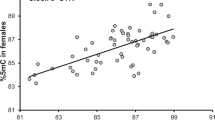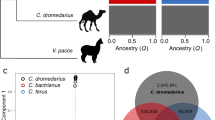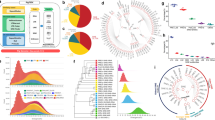Abstract
Domestication is one of the strongest examples of artificial selection and has produced some of the most extreme within-species phenotypic variation known. In the case of the chicken, it has been hypothesized that DNA methylation may play a mechanistic role in the domestication response. By inter-crossing wild-derived red junglefowl with domestic chickens, we mapped quantitative trait loci for hypothalamic methylation (methQTL), gene expression (eQTL) and behaviour. We find large, stable methylation differences, with 6,179 cis and 2,973 trans methQTL identified. Over 46% of the trans effects were genotypically controlled by five loci, mainly associated with increased methylation in the junglefowl genotype. In a third of eQTL, we find that there is a correlation between gene expression and methylation, while statistical causality analysis reveals multiple instances where methylation is driving gene expression, as well as the reverse. We also show that methylation is correlated with some aspects of behavioural variation in the inter-cross. In conclusion, our data suggest a role for methylation in the regulation of gene expression underlying the domesticated phenotype of the chicken.
This is a preview of subscription content, access via your institution
Access options
Access Nature and 54 other Nature Portfolio journals
Get Nature+, our best-value online-access subscription
$29.99 / 30 days
cancel any time
Subscribe to this journal
Receive 12 digital issues and online access to articles
$119.00 per year
only $9.92 per issue
Buy this article
- Purchase on Springer Link
- Instant access to full article PDF
Prices may be subject to local taxes which are calculated during checkout



Similar content being viewed by others
Data availability
Microarray data for the chicken hypothalamus tissue are available at E-MTAB-3154 in ArrayExpress. DNA methylation and behavioural phenotypes (https://doi.org/10.6084/m9.figshare.12803873), genotypes (https://doi.org/10.6084/m9.figshare.12803876) and a readymade QTL cross-file (https://doi.org/10.6084/m9.figshare.12803870) are available via Figshare.
References
Jensen, P. & Wright, D. in Genetics and Behavior of Domestic Animals (eds Grandin, T. & Deesing, M. J.) 41–80 (Academic Press, 2014).
Wright, D. The genetic architecture of domestication in animals. Bioinform. Biol. Insights 9, 11–20 (2015).
Fumihito, A., Miyake, T., Sumi, S. I., Ohno, S. & Kondo, N. One species of the red junglefowl (Gallus gallus gallus) suffices as the matriarchic ancestor of all domestic breeds. Proc. Natl Acad. Sci. USA 91, 12505–12509 (1994).
Fumihito, A. et al. Monophyletic origin and unique dispersal patterns of domestic fowls. Proc. Natl Acad. Sci. USA 93, 6792–6795 (1996).
Frantz, L. A. & Larson, G. in Hybrid Communities: Biosocial Approaches to Domestication and Other Trans-species Relationships (eds Stépanoff, C. & Vigne, J.-D.) Ch. 1 (Taylor & Francis, 2018).
Larson, G. et al. Current perspectives and the future of domestication studies. Proc. Natl Acad. Sci. USA 111, 6139–6146 (2014).
Larson, G. & Fuller, D. Q. The evolution of animal domestication. Annu. Rev. Ecol. Evol. Syst. 45, 115–136 (2014).
Johnsson, M., Jonsson, K. B., Andersson, L., Jensen, P. & Wright, D. Quantitative trait locus and genetical genomics analysis identifies putatively causal genes for fecundity and brooding in the chicken. G3 (Bethesda) https://doi.org/10.1534/g3.115.024299 (2015).
Henriksen, R., Johnsson, M., Andersson, L., Jensen, P. & Wright, D. The domesticated brain: genetics of brain mass and brain structure in an avian species. Sci. Rep. 6, https://doi.org/10.1038/srep34031 (2016).
Johnsson, M., Jonsson, K. B., Andersson, L., Jensen, P. & Wright, D. Genetic regulation of bone metabolism in the chicken: similarities and differences to mammalian systems. PLoS Genet. 11, e1005250 (2015).
Johnsson, M. et al. Genetical genomics of growth in a chicken model. BMC Genom. 19, 72 (2018).
Johnsson, M. et al. A sexual ornament in chickens is affected by pleiotropic alleles at HAO1 and BMP2, selected during domestication. PLoS Genet. 8, e1002914 (2012).
Fogelholm, J. et al. Genetical genomics of tonic immobility in the chicken. Genes 10, 341 (2019).
Johnsson, M. et al. Genetics and genomics of social behavior in a chicken model. Genetics 209, 209–221 (2018).
Johnsson, M., Williams, M. J., Jensen, P. & Wright, D. Genetical genomics of behavior: a novel chicken genomic model for anxiety behavior. Genetics 202, 327–340 (2016).
Bélteky, J. et al. Epigenetics and early domestication: differences in hypothalamic DNA methylation between red junglefowl divergently selected for high or low fear of humans. Genet. Sel. Evol. 50, 13 (2018).
Pértille, F. et al. Mutation dynamics of CpG dinucleotides during a recent event of vertebrate diversification. Epigenetics 14, 685–707 (2019).
Nätt, D. et al. Heritable genome-wide variation of gene expression and promoter methylation between wild and domesticated chickens. BMC Genom. 13, 59 (2012).
Gaston, K. & Fried, M. CpG methylation has differential effects on the binding of YY1 and ETS proteins to the bi-directional promoter of the Surf-1 and Surf-2 genes. Nucleic Acids Res. 23, 901–909 (1995).
Mann, I. K. et al. CG methylated microarrays identify a novel methylated sequence bound by the CEBPB| ATF4 heterodimer that is active in vivo. Genome Res. 23, 988–997 (2013).
Yin, Y. et al. Impact of cytosine methylation on DNA binding specificities of human transcription factors. Science 356, eaaj2239 (2017).
Bogdanović, O. et al. Active DNA demethylation at enhancers during the vertebrate phylotypic period. Nat. Genet. 48, 417–426 (2016).
Murtha, M. & Esteller, M. Extraordinary cancer epigenomics: thinking outside the classical coding and promoter box. Trends Cancer 2, 572–584 (2016).
Heyn, H. et al. Epigenomic analysis detects aberrant super-enhancer DNA methylation in human cancer. Genome Biol. 17, 11 (2016).
Ruden, D. M. et al. Epigenetics as an answer to Darwin’s “special difficulty,” part 2: natural selection of metastable epialleles in honeybee castes. Front. Genet. 6, 60 (2015).
Anastasiadou, C., Malousi, A., Maglaveras, N. & Kouidou, S. Human epigenome data reveal increased CpG methylation in alternatively spliced sites and putative exonic splicing enhancers. DNA Cell Biol. 30, 267–275 (2011).
Kasowski, M. et al. Extensive variation in chromatin states across humans. Science 342, 750–752 (2013).
Kilpinen, H. et al. Coordinated effects of sequence variation on DNA binding, chromatin structure, and transcription. Science 342, 744–747 (2013).
McVicker, G. et al. Identification of genetic variants that affect histone modifications in human cells. Science 342, 747–749 (2013).
Guerrero-Bosagna, C. From epigenotype to new genotypes: relevance of epigenetic mechanisms in the emergence of genomic evolutionary novelty. Semin. Cell Dev. Biol. 97, 86–92 (2020).
Furey, T. S. & Sethupathy, P. Genetics driving epigenetics. Science 342, 705–706 (2013).
Bell, J. T. et al. DNA methylation patterns associate with genetic and gene expression variation in HapMap cell lines. Genome Biol. 12, R10 (2011).
Imgenberg-Kreuz, J. et al. DNA methylation mapping identifies gene regulatory effects in patients with systemic lupus erythematosus. Ann. Rheum. Dis. 77, 736–743 (2018).
Bonder, M. J. et al. Disease variants alter transcription factor levels and methylation of their binding sites. Nat. Genet. 49, 131–138 (2017).
Gibbs, J. R. et al. Abundant quantitative trait loci exist for DNA methylation and gene expression in human brain. PLoS Genet. 6, e1000952 (2010).
Dubin, M. J. et al. DNA methylation in Arabidopsis has a genetic basis and shows evidence of local adaptation. eLife 4, e05255 (2015).
Aten, J. E., Fuller, T. F., Lusis, A. J. & Horvath, S. Using genetic markers to orient the edges in quantitative trait networks: the NEO software. BMC Syst. Biol. 2, 34 (2008).
Henriksen, R. et al. Intra-individual behavioural variability: a trait under genetic control. Preprint at bioRxiv https://doi.org/10.1101/795864 (2019).
Farber, C. R. et al. Genetic dissection of a major mouse obesity QTL (Carfhg2): integration of gene expression and causality modeling. Physiol. Genomics 37, 294–302 (2009).
Plaisier, C. L. et al. A systems genetics approach implicates USF1, FADS3, and other causal candidate genes for familial combined hyperlipidemia. PLoS Genet. 5, e1000642 (2009).
Laine, V. N. et al. Evolutionary signals of selection on cognition from the great tit genome and methylome. Nat. Commun. 7, 10474 (2016).
Hu, Y. et al. Comparison of the genome-wide DNA methylation profiles between fast-growing and slow-growing broilers. PLoS ONE 8, e56411 (2013).
Meng, D. et al. Limited contribution of DNA methylation variation to expression regulation in Arabidopsis thaliana. PLoS Genet. 12, e1006141 (2016).
Watt, F. & Molloy, P. L. Cytosine methylation prevents binding to DNA of a HeLa cell transcription factor required for optimal expression of the adenovirus major late promoter. Genes Dev. 2, 1136–1143 (1988).
Zhang, W., Spector, T. D., Deloukas, P., Bell, J. T. & Engelhardt, B. E. Predicting genome-wide DNA methylation using methylation marks, genomic position, and DNA regulatory elements. Genome Biol. 16, 14 (2015).
Eckhardt, F. et al. DNA methylation profiling of human chromosomes 6, 20 and 22. Nat. Genet. 38, 1378–1385 (2006).
Perzel Mandell, K. A. et al. Characterizing the dynamic and functional DNA methylation landscape in the developing human cortex. Preprint at bioRxiv https://doi.org/10.1101/823781 (2019).
Wang, F. et al. ACOT1 expression is associated with poor prognosis in gastric adenocarcinoma. Hum. Pathol. 77, 35–44 (2018).
Pang, K. et al. The ERH gene regulates migration and invasion in 5637 and T24 bladder cancer cells. BMC Cancer 19, 225 (2019).
Yamaguchi, S., Asao, T., Nakamura, J.-I., Ide, M. & Kuwano, H. High frequency of DAP-kinase gene promoter methylation in colorectal cancer specimens and its identification in serum. Cancer Lett. 194, 99–105 (2003).
Kasai, N. et al. Anti-tumor efficacy evaluation of a novel monoclonal antibody targeting neutral amino acid transporter ASCT2 using patient-derived xenograft mouse models of gastric cancer.Am. J. Transl. Res. 9, 3399–3410 (2017).
Arrieta, O. et al. Gene Expression Signature to predict early development of brain metastasis in lung adenocarcinoma. J. Clin. Oncol. 33, https://doi.org/10.1200/jco.2015.33.15_suppl.e19064 (2015).
Sanchez-Carbayo, M. et al. 772: identification of genetic signatures associated with TP53 status in patients with bladder cancer. J. Urol. 173, 209–210 (2005).
Hair, B. Y. et al. Body mass index associated with genome-wide methylation in breast tissue. Breast Cancer Res. Treat. 151, 453–463 (2015).
Case, C. Neural regenerating cells with alterations in DNA methylation. Google patent US10316288B2 (2019).
Wang, K.-S. et al. A novel locus for body mass index on 5p15.2: a meta-analysis of two genome-wide association studies. Gene 500, 80–84 (2012).
Morahan, J. M., Yu, B., Trent, R. J. & Pamphlett, R. A genome-wide analysis of brain DNA methylation identifies new candidate genes for sporadic amyotrophic lateral sclerosis. Amyotroph. Lateral Scler. 10, 418–429 (2009).
Singh, B., Carpenter, G. & Coffey, R. J. EGF receptor ligands: recent advances. F1000Research 5, 3399–3410 (2016).
Xu, H. et al. Characterization of the Goose CAPN3 gene and its expression pattern in muscle tissues of sichuan white geese at different growth stages. J. Poult. Sci. 55, 172–181 (2018).
Sha, Y.-W. et al. Sperm-egg fusion disorder in a Chinese male patient was associated with a rare ADAM20 variant. Oncotarget 9, 2086–2091 (2018).
Sigdel, A., Liu, L., Abdollahi-Arpanahi, R., Aguilar, I. & Peñagaricano, F. Genetic dissection of reproductive performance of dairy cows under heat stress. Anim. Genet. 51, 511–520 (2020).
Suzuki, M. et al. Site-specific DNA methylation by a complex of PU.1 and Dnmt3a/b. Oncogene 25, 2477–2488 (2006).
Maurano, M. T. et al. Role of DNA methylation in modulating transcription factor occupancy. Cell Rep. 12, 1184–1195 (2015).
Shulha, H. P. et al. Human-specific histone methylation signatures at transcription start sites in prefrontal neurons. PLoS Biol. 10, e1001427 (2012).
Zhang, D. et al. Genetic control of individual differences in gene-specific methylation in human brain. Am. J. Hum. Genet. 86, 411–419 (2010).
Du, Y., Chen, Y., Wang, F. & Gu, L. miR-137 plays tumor suppressor roles in gastric cancer cell lines by targeting KLF12 and MYO1C. Tumor Biol. 37, 13557–13569 (2016).
Liu, J., Morgan, M., Hutchison, K. & Calhoun, V. D. A study of the influence of sex on genome wide methylation. PLoS ONE 5, e10028 (2010).
Cámara, Y. et al. MTERF4 regulates translation by targeting the methyltransferase NSUN4 to the mammalian mitochondrial ribosome. Cell Metab. 13, 527–539 (2011).
Wang, L. et al. CARM1 methylates chromatin remodeling factor BAF155 to enhance tumor progression and metastasis. Cancer Cell 25, 21–36 (2014).
Forcella, M. et al. Neuronal specific and non-specific responses to cadmium possibly involved in neurodegeneration: a toxicogenomics study in a human neuronal cell model. Neurotoxicology 76, 162–173 (2020).
Cheng, Z. et al. Genome-wide scan identifies opioid overdose risk locus close to MCOLN1. Addiction Biol. 25, e12811 (2020).
Harrison, V. et al. Compound heterozygous deletion of NRXN1 causing severe developmental delay with early onset epilepsy in two sisters. Am. J. Med. Genet. A 155, 2826–2831 (2011).
Heinrich, H. et al. Attention, cognitive control and motivation in ADHD: linking event-related brain potentials and DNA methylation patterns in boys at early school age. Sci. Rep. 7, 3823 (2017).
Frey, S. et al. Prenatal alcohol exposure is associated with adverse cognitive effects and distinct whole-genome DNA methylation patterns in primary school children. Front. Behav. Neurosci. 12, https://doi.org/10.3389/fnbeh.2018.00125 (2018).
Marshall, C. R. et al. Structural variation of chromosomes in autism spectrum disorder. Am. J. Hum. Genet. 82, 477–488 (2008).
Chang, J., Baloh, R. H. & Milbrandt, J. The NIMA-family kinase Nek3 regulates microtubule acetylation in neurons. J. Cell Sci. 122, 2274–2282 (2009).
Miller, D., Forrester, K., Leonard, C., Salo, P. & Bray, R. C. ACL deficiency impairs the vasoconstrictive efficacy of neuropeptide Y and phenylephrine in articular tissues: a laser speckle perfusion imaging study. J. Appl. Physiol. 98, 329–333 (2005).
Viitaniemi, H. M. et al. Seasonal variation in genome-wide DNA methylation patterns and the onset of seasonal timing of reproduction in great tits. Genome Biol. Evol. 11, 970–983 (2019).
Verhulst, E. C. et al. Evidence from pyrosequencing indicates that natural variation in animal personality is associated with DRD 4 DNA methylation. Mol. Ecol. 25, 1801–1811 (2016).
Sepers, B. et al. Avian ecological epigenetics: pitfalls and promises. J. Ornithol. 160, 1183–1203 (2019).
Schrey, A. W. et al. Epigenetic variation may compensate for decreased genetic variation with introductions: a case study using house sparrows (Passer domesticus) on two continents. Genetics Res. Int. 2012, 979751 (2012).
Riyahi, S. et al. Natural epigenetic variation within and among six subspecies of the house sparrow, Passer domesticus. J. Exp. Biol. 220, 4016–4023 (2017).
van Oers, K. & Naguib, M. in Animal Personalities: Behavior, Physiology, and Evolution (eds Maestripieri, D. & Carere, C.) 66–95 (Univ. Chicago Press, 2013).
Santure, A. W. et al. Replicated analysis of the genetic architecture of quantitative traits in two wild great tit populations. Mol. Ecol. 24, 6148–6162 (2015).
Kim, J. M. et al. A high-density SNP chip for genotyping great tit (Parus major) populations and its application to studying the genetic architecture of exploration behaviour. Mol. Ecol. Resour. 18, 877–891 (2018).
Guerrero-Bosagna, C., Settles, M., Lucker, B. & Skinner, M. K. Epigenetic transgenerational actions of vinclozolin on promoter regions of the sperm epigenome. PLoS ONE 5, e13100 (2010).
Weber, M. et al. Chromosome-wide and promoter-specific analyses identify sites of differential DNA methylation in normal and transformed human cells. Nat. Genet. 37, 853–862 (2005).
Li, H. et al. The sequence alignment/map format and SAMtools. Bioinformatics 25, 2078–2079 (2009).
Broman, K. W., Wu, H., Sen, S. & Churchill, G. A. R/qtl: QTL maping in experimental crosses. Bioinformatics 19, 889–890 (2003).
Acknowledgements
The research was carried out within the framework of the Swedish Centre of Excellence in Animal Welfare Science, and the Linköping University Neuro-network. SNP genotyping was performed by the Uppsala Sequencing Center. Bioinformatic support was provided by NBIS (National Bioinformatics Infrastructure Sweden). The project was supported by grants from the European Research Council (advanced grant GENEWELL and Consolidator grant FERALGEN 772874), the Swedish Research Council (VR), Carl Tryggers Stiftelse, and the Linköping University Neuro-network.
Author information
Authors and Affiliations
Contributions
D.W. and P.J. conceived the study. D.W., A.H., M.J., R.H. and J.F. collected data. A.H., R.H., C.M.G.-B., A.M.C., A.M.-B., M.J. and J.F. performed the analyses. D.W., A.H., R.H. and P.J. wrote the initial draft of the manuscript; all authors revised and contributed to the initial and final drafts.
Corresponding author
Ethics declarations
Competing interests
The authors declare no competing interests.
Additional information
Publisher’s note Springer Nature remains neutral with regard to jurisdictional claims in published maps and institutional affiliations.
Extended data
Extended Data Fig. 1 Percentage of variation in gene expression explained by methylation and genotype in the significantly correlated methQTL/ eQTL candidates.
Percentage of variation in gene expression explained by methylation and genotype in the significantly correlated methQTL/ eQTL candidates. Genes possessing an eQTL are subdivided into the total % of variation that can be accounted for in a model including eQTL genotype, sex and methylation from any significant methQTL (that is genotype, sex and methylation together explain 10–20% of variation in gene expression in the smallest category, and over 50% of gene expression variation in the largest category). The explained gene expression variation in each category is then separated into the % of variation explained by the eQTL genotype and sex and the % variation explained by methylation. In the case of the category for >50% variation explained in gene expression, only four methQTL/ eQTL models fell into this bracket.
Supplementary information
Supplementary Information
Supplementary Table 11.
Supplementary Tables
Supplementary Tables 1–10.
Rights and permissions
About this article
Cite this article
Höglund, A., Henriksen, R., Fogelholm, J. et al. The methylation landscape and its role in domestication and gene regulation in the chicken. Nat Ecol Evol 4, 1713–1724 (2020). https://doi.org/10.1038/s41559-020-01310-1
Received:
Accepted:
Published:
Issue Date:
DOI: https://doi.org/10.1038/s41559-020-01310-1



